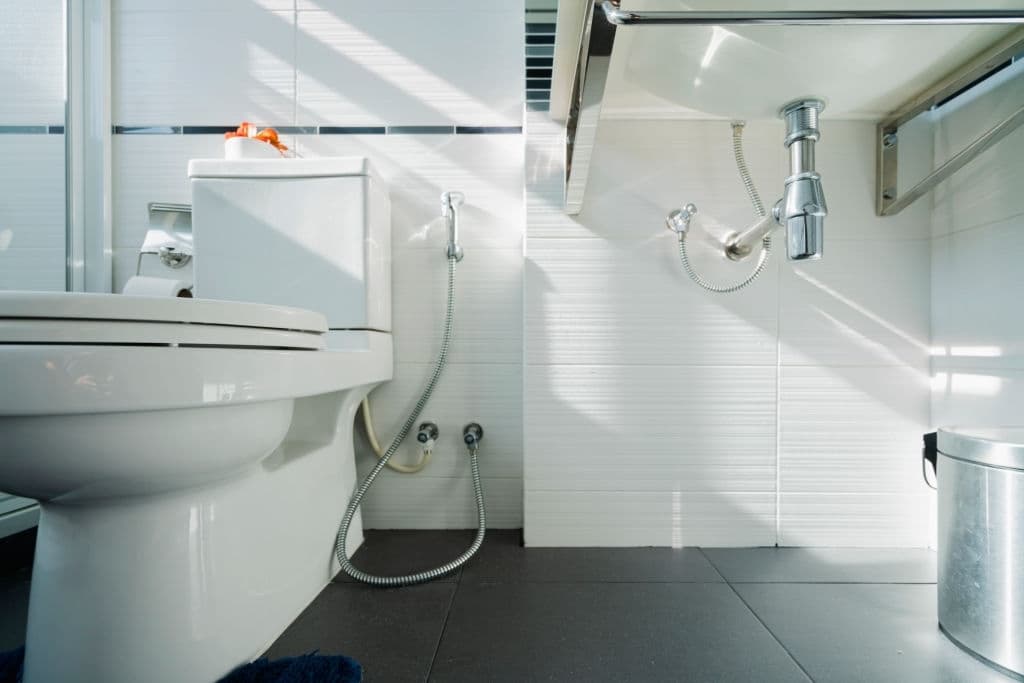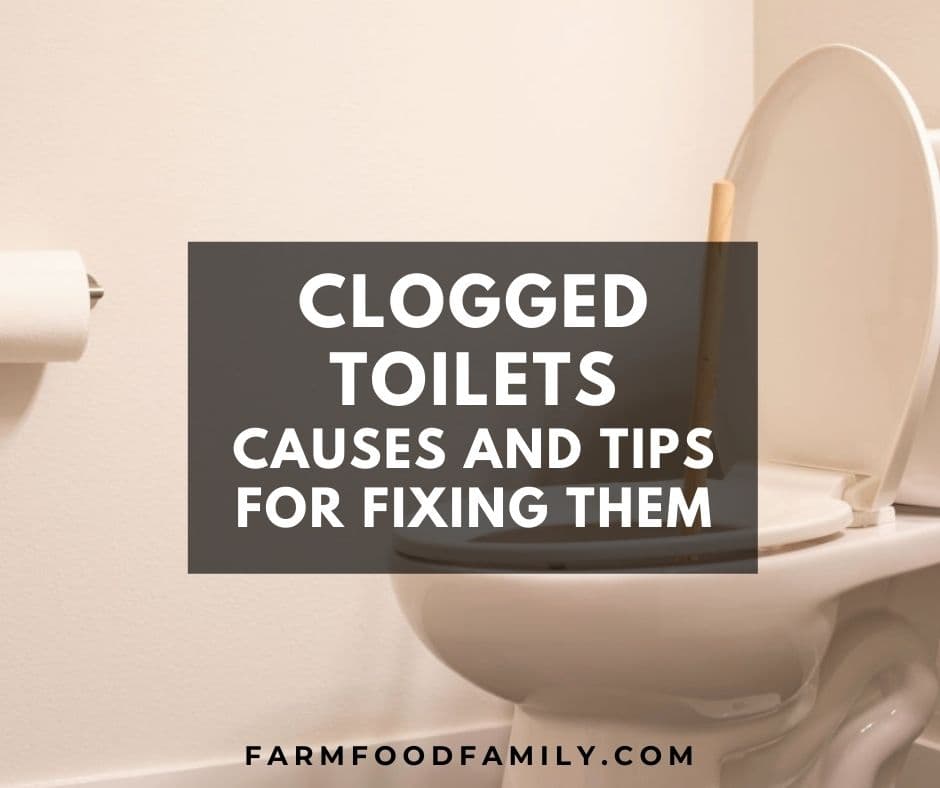
In today’s world, a toilet is no longer just a convenience. Instead, it’s a must-have in any home. When you are dealing with a clogged toilet, it is essential to figure out what could be causing the problem and fix it.
The causes of a clogged toilet can be as simple as a curious child or an adult putting lots of toilet paper into the bowl before flushing. It can also be as complex as damaged sewer lines.
The good thing is that some of these problems can be fixed using a plunger or hiring a professional plumber at an affordable rate. Normally, when a toilet keeps clogging, it’s because there are tons of numerous underlying issues in your drain lines. Keep reading to learn more about what causes toilets to clog and tips for fixing them.
Related: How to Unclog A Toilet When Nothing Works (9 Methods)
Common Causes of Clogged Toilets and What to Do
1. Clogged drain

There are instances where the age of the drain line would work against your plumbing system. This may cause the drain line to clog when you attempt to flush toilet paper or regular flushable wastes. Among the objects that would cause a drain to clog is hair, foreign objects, or paper.
A blockage would occur when these clogs exit your toilet bowl and become trapped in the drains. Clogged drains can cause significant drainage problems throughout your entire home. These clogs are often difficult to clear.
What to do:
If your house is old that would mean that your drain is fragile. You will, therefore, need a nearest drain cleaning service or a plumber to replace the whole system. There are, however, some things you can do to get your toilets working before you save enough money for a complete replacement. They include:
Using a plunger
If your toilet bowl has flooded, you first need to remove the water manually. You can then plunge without splashing the wastewater. The next step is to gently plunge the toilet bowl while letting our air from inside the plunger.
Move the plunger up and down for a few minutes, and then fill a container with water and pour it into the toilet. If the level of water fails to drop, continue plunging and pouring water until the clog is completely dislodged.
Using soap and hot water
If you do not have a plunger, you should use soap and hot water to dissolve the clog. To use this technique, you need to remove water from the toilet bowl so that there is room to add your unclogging liquid.
Add a shampoo and some slivers of bar soap followed by a gallon of hot water. You should then wait for 20 minutes to allow the clog to break then flush the toilet.
Using Makeshift drain snake
You can transform a coat hanger into a makeshift snake drain and use it to dislodge the blockage. To use the hanger, you need to first unravel and straighten it. Make sure you wear a pair of gloves to protect your skin while unraveling this wire.
You should then wrap one end of the hanger with duct tape so that it does not scratch the toilet. Use the makeshift drain to push the debris down the drain to enable you to flush. If you continue to feel the obstruction, keep on twisting the wire in a circular motion for a few minutes and then flush the toilet.
Related: 2 Worst Toilet Brands To Avoid and 17 Reliable Brands (Buying Guide)
2. Damaged sewer lines

The main sewer lines that exit your home run underground out to the septic tank or the municipal sewer system. Despite the sewer line being located below the ground protected from sleet, snow, and rain, it can be punctured by tree roots, thereby affecting your toilet.
Extreme temperatures and corroded pipes can also make the sewer line susceptible to cracks and leaks. When the main sewer line is compressed or punctured, the municipal sewer system and septic tank are constricted. What’s more, dirt, rocks, and other debris can enter your sewer system through punctures, creating a drainage problem. You will know that your sewer line is blocked when you notice signs such as:
- Backups and clogs in your toilet
- An unpleasant smell of sewer gas coming from your drains
- Soggy and foul-smelling lawn
- Rodent and pest infestations
- Mold and mildew on your home walls, floors, and ceilings.
Related: Is a Tankless Toilet Right for your Home? – Price, Pros and Cons, Problems, Installation
What to do
A punctured, restricted, or damaged sewer line is a complex problem that only a licensed plumber can fix. A sewer line repair can be costly and time-consuming because it requires digging around the sewer pipes to fix the problem.
When you call in a plumber, they often begin by diagnosing the extent of the damage using a video camera down the sewer line. Depending on the magnitude of the damage, a plumber will either perform pipe lining or replacement.
For minimal damage, a plumber will conduct pipe lining with epoxy to harden the leak area. However, extensive damage will require conventional sewer line replacement.
To ensure that your sewer lines don’t clog your toilet, you should remove trees from the area after repair to prevent future damage. You should also hire a professional plumber to perform sewer line inspections at least once a year to check for corrosion and blockages.
Additionally, you should use your sewage system properly by only disposing of human waste and toilet paper in your toilet. This approach will ensure that other blockage materials never interfere with your plumbing system.
Related: Sewer Clean Out: Installation, Cost, and How To Locate It
3. An ineffective low-flow toilet

Low-flow toilets are a great option when you want to lower your water bill. Given that toilets can last for a decade without requiring an update or replacement of any kind, old low-flow toilets can easily clog.
The explanation behind this is that compared to the standard new model toilets that use 1.6 gallons of water, low-flow toilets use approximately 1.2 gallons per flush. This means that the power of a single flush cannot push waste and toilet paper completely through your P-trap or S-trap into the drain pipe and eventually to the septic tanks.
What to do
Fortunately, there are ways that you could adjust your low-flow toilet so that it has enough water to flush waste. How you adjust your toilet, however, depends on the kind of float that the toilet’s water tank has. Some of the strategies that you could adopt include:
Adjusting the plunger/piston ballcock
The plunger/piston ballcock gets its name from its shape. It’s made up of a brass rod connected to a piston or plunger. To adjust this float, you need to bend the brass flow upward gently to elevate the water level in the tank. While you do this, you should make sure that the water level falls below the tank’s overflow tube.
Adjust the brass diaphragm ballcock
Like the plunger/piston ballcock, a brass diaphragm ballcock uses a diaphragm to control the water level. To increase the height of the water in the tank, you should bend the brass rod upwards while ensuring that there is no flow of water into the overflow tube.
Raise/lower the float-cup fill valve
You can adjust the float cup and change the level of the water by pinching the metal spring clip. This approach will allow you to raise and lower the water level as needed.
Twist the internal float fill valve
Unlike the float-cup fill valve, the internal float fill valve is normally hidden inside the tank. To adjust the water level, you need to unlock it by moving the valve counter-clockwise to increase the water and clockwise to lock it when the water is at the height that you want.
Turn the pressure/floatless-activated fill valve
This fixture uses a pressure-sensing mechanism to determine the level of the water in the tank. Adjusting the water level will require you to turn the valve clockwise and counter-clockwise to raise and lower the water height as desired.
Related: Choosing the Right Bathroom Faucet Valve and Finish for the Job
4. A blocked S-Trap
An S-trap is an S-shaped pipe that is visible at the back of your toilet. It stems from the ground and winds into the toilet bowl. This pipe ensures that foul-smelling sewer gases do not pass through your toilet bowl to your home. New toilet designs lack this pipe but have a P-trap instead.
An S-trap or P-trap can clog due to dirt build-up, soap, hair, mineral build-up, and small objects. A partially clogged S-trap or P-trap can be hard to detect. But when completely clogged, it causes your toilet to block instantly. You’ll know you’re dealing with a clogged S-trap or P-trap when you notice a nasty smell and persistent toilet overflow.
What to do
Often, plunging is effective to clear most of the clogs. It is the first method that you should consider to fix this problem. When plunging fails to work, it tells you that whatever is blocking your trap is a hard object that requires more stringent methods.
In such cases, you should consider using a toilet auger, which is also known as a flange plunger. This device has a bell-shaped cup with an extendable flange that fits inside the toilet bowl.
You should poke your trap in a circular motion with the auger several times to break down the clog then pour water into the toilet bowl to wash away the debris. A toilet auger works just like a drain snake. Consequently, you need to empty your overflowing toiled first to avoid creating a mess while using the auger.
Should this technique fail to work, you need to call in a plumber because it’s a clear indication that the problem is much bigger. Emergency plumbers often come to your aid in a matter of minutes and will resolve your problem instantly. To prevent future emergencies, you need to hire a licensed, insured, and bonded plumber who will regularly inspect your plumbing system to correct minor defects.
5. Wrong/too much toilet paper!

Toilet tissue paper is supposed to dissolve immediately it gets into contact with water. Not all brands will dissolve properly, however. There are so many costly and cheap toilet paper brands that refuse to fall apart once in the toilet bowl.
Some toilet papers are as strong as a newspaper print and when used they instantly clog your toilet. When you have children around, they can worsen the situation by stuffing too much toilet paper in your toilet. The situation could be compounded, resulting in a backup if there is already an existing clog in your pipes.
What to do
Toilet paper comes in 1,2 and 3-ply versions. When you purchase the 1-ply toilet paper, you will find that most people will use a lot of it, and you will end up with the same clogging issue.
The 3-ply toilet paper, on the other hand, dissolves slowly and when your water pressure is low, it will give you blockage issues as well. Of all of these options, the 2-ply is a great option. The 2-ply tissue paper is both soft and less bulky. The toilet paper is convenient for use in your toilet.
If you still can’t choose the best toilet paper brand to use, you should consider the alternatives below:
Bidet
When you have a bidet installed in your bathroom, you will have enhanced your bathroom experience and will never have to deal with blocked traps and drains. You can buy a bidet from your local hardware store or online and have your plumber fix it for you.
Reusable toilet cloth
You could also put up a family cloth in the bathroom for cleaning up after use. You can make a toilet cloth out of old towels or t-shirts that you no longer use.
Depending on the number of people in your home, you could make each person a cloth which they rinse after use. Reusable toilet cloths may seem unconventional, but they will save your toilet from occasional clogging.
Flushable wipes
In recent years, flushable wipes have become popular among people. Numerous companies are currently manufacturing these easy to dissolve wipes that will ensure that your toilet doesn’t block.
Baby pipes
Rather than using toilet paper that causes sewage back-up, you could also use baby wipes that you throw in the bin after use. However, if you live with several people in the house, you need to specify that the wipes go into the bin and not the toilet lest you block your toilet.
Related: 20+ Toilet Paper Holder Ideas
6. Hard water
You should know that hard water is full of minerals. These minerals include calcium and magnesium. They usually get deposited inside your drain pipes over time, creating a clog.
This problem is exacerbated if your toilet is old and has a poor flusher. Hard water mainly comes from the wells and mostly affects people living in rural settings. Also, if you use too chlorinated water, you are building plaque on your toilet.
The reason is that chlorine damages the plastic and rubber parts of your toilet. It causes them to break after some time. Over time, parts of your broken pipes will build up along your plumbing system creating a serious blockage.
What to do
Instead of using hard-well water, you should consider investing in a water softener to get rid of minerals. A water softener is a house filtration system that will remove calcium and magnesium through an ion-exchange method. You can buy the system at a local store. You can then have it installed in your house. Installation of this device is simple and involves the steps below:
- Position the water softener system so that the inlet is connected to the water supply and the outlet faces the direction of the hot water appliances
- Ensure that you turn off the water supply from the mainline to prevent leaks during the installation process. Also, turn off the water heater supply at the electricity unit.
- Drain your pipes by opening all of your faucets in the house to ensure that all the water exits your home’s supply pipes.
- Cut into your main water supply line and connect the water softener inlet to it.
- Measure, cut, and connect the pipes before attaching them to your water softener. In case you are using pipes made of copper, you need to solder on the nipples and respective fittings before you connect them to your new system.
- Clamp the drain hose so that your water softener drains the brine solution after the regeneration cycle.
- Lastly, connect the overflow tube to prevent the brine tank from overflowing. This step is just a precaution to avoid contaminating your water.
While at it, you need to ensure that you remove the clogged old pipes for a fresh start.
7. Obstructed plumbing vents
Your plumbing system relies on ventilation pipes to release sewer gases from your home. In their absence, you would have gas building up in your drain pipes. The sewer gas build-up will certainly contaminate the air in your home.
The vents also allow clean air into your home by creating suction and pressure within your plumbing lines.
It is this pressure that also enhances your toilet’s flushing power. However, should your plumbing vent be clogged, obstructed, or otherwise sealed, it would mean that your flushing power is also greatly reduced. You can also tell that your vent is obstructed when you notice that:
- Your drain takes forever to drain
- You hear gurgling sounds when water goes down the drain
- You experience dry or empty toilet tanks all the time
You should know that your vent controls air pressure in your whole plumbing system hence it should not be ignored.
What to do
If you suspect a clogged vent, the first thing you need to do is verify whether your suspicion is true by climbing onto the roof of your house. However, you cannot solve this problem alone because you will need one person to remain in the house, while the other holds the ladder for you when you climb.
The person in the house should flush the toilet while you hold your hand over the vent. If your experience no suction from the vent, that confirms that your vent is blocked at the outlet.
Your plumbing vent can be blocked by too much dust, debris getting trapped in the vent, leaves from surrounding trees, or other things such as dead animals. You can clean the vent yourself by using a garden hose to flush out debris.
You can also use a plumber’s snake to unclog what might be blocking your vent. After cleaning, you should install a proper vent cap to keep off environmental debris from getting into the vent. Additionally, you need to keep out pests and vermin in your home and trim tree branches whose branches have extended close to your vent.
When all these techniques fail to work, it is a clear indication that your vent was not properly designed or installed. In such scenarios, you need to call in a plumbing contractor to demolish and reposition your vent properly.
A wrongly installed vent is something that you will notice within a few weeks after moving to a newly built or renovated house. If you live in a multi-story apartment; you need to call an emergency plumber immediately when you suspect your vent has an issue. The reason is that multiple-story buildings have complex vet systems and should be left to a professional plumber.
Final Thoughts
Toilet clogs are horrifying, messy, and frustrating. The causes of toilets clogs could be simple issues, such as hair or toilet build-up. They could also be complex problems that touch on the main sewer lines. Signs of toilet clogs that range from overflowing toilet bowls, gurgling noises, to fluid leaking out should not be ignored. These signs could be indications of a much bigger problem within your entire plumbing system.
When overlooked, a toilet clog can become too expensive to fix. It can also contaminate your home when there is an overflow. The outcome is a disease outbreak. Whether you are big on fixing the problems yourself or engaging a professional, you should fix the problem once you spot it.
It is good to have a plumber on call to avoid emergencies that would render your home inhabitable. Currently, you can find emergency plumbing companies in almost all the towns. Thus, you should not let your toilet embarrass you!











